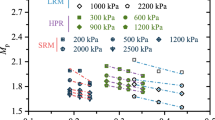Abstract
The plastic potential and yield functions are two of the most important components of elastoplastic constitutive models. Because the incremental plastic energy-based equation of the Cam-Clay model does not consider the particle breakage energy, the predicted results for crushable granular material, e.g., rockfills, are not convincing. It should be noted that the particle breakage energy is difficult to be quantified separately, and to avoid directly measuring it, the total input energy during shearing is taken as the equivalent of the energy-based equation in this study. Accordingly, a unified function with two parameters (critical stress ratio Mc and χ) is derived for defining the yield and the plastic potential surfaces for rockfills. When χ = 1.0, the yield locus f is equal to the plastic potential surface g, when χ > 1.0, f is below g, and f tends to become more bullet-shaped with an increasing χ, and when χ < 1.0, f is above g, and f tends to become more drop-shaped with a decreasing χ. Additionally, the experimental plastic strain increment vectors of the Pancrudo slate rockfill (Alonso 2016) are not normal to the yield locus, which demonstrates that the proposed unified function is reasonable.











Similar content being viewed by others

Abbreviations
- \(\sigma_{1},\sigma_{2},\sigma_{3}\) :
-
major, intermediate, and minor principal stresses
- \(\varepsilon_{1},\varepsilon_{2},\varepsilon_{3}\) :
-
major, intermediate, and minor principal strains
- p :
-
mean normal stress, \(p=\frac{\sigma_{1}+\sigma_{2}+\sigma_{3}}{3}\)
- q :
-
shear stress, \(q=\frac{1}{\sqrt{2}}\sqrt{(\sigma_{1}-\sigma_{2})^{2}+(\sigma_{2}-\sigma_{3})^{2}+(\sigma_{3}-\sigma_{1})^{2}}\)
- \(d\varepsilon^{p}_{v},d\varepsilon^{p}_{s}\) :
-
increment in the plastic volumetric strain and the plastic shear strain
- \(d\varepsilon_{v}{,d\varepsilon},\) :
-
increment in the volumetric strain and the shear strain
- dg :
-
incremental strain ratio, \(d_g=\frac{d\varepsilon_v^p}{d\varepsilon_v^p}\approx\frac{d\varepsilon_{v}}{d\varepsilon_{s}}\)
- \(\eta\) :
-
stress ratio, \(\eta=q/p\)
- Es :
-
input energy during shearing
- \(p_{c},q_{c}\) :
-
mean normal stress and shear stress at the critical state
- \(M_{c}\) :
-
critical state stress ratio,\(M_{c}=q_{c}/p_{c}\)
- k :
-
slope in terms of \(Es\sim\varepsilon_{s}\)
- g :
-
plastic potential function
- f :
-
yield function
- χ :
-
parameter of the yield function
References
Alonso EE, Romero EE, Ortega E (2016) Yielding of rockfill in relative humidity-controlled triaxial experiments. Acta Geotech 11(3):455–477
Guo WL, Zhu JG (2017) Particle breakage energy and stress dilatancy in drained shear of rockfills. Géotechnique Letters 7:304–308
Guo WL, Cai ZY, Wu YL, Geng ZZ (2019) Estimations of three characteristic stress ratios for rockfill material considering particle breakage. Acta Mech Solida Sin 32(2):215–229
Lade PV, Yamamuro JA, Bopp PA (1996) Significance of particle crushing in granular materials. J Geotech Eng 122(4):309–316
Lagioia R, Nova R (1995) An experimental and theoretical study of the behaviour of a calcarenite in triaxial compression. Géotechnique 45(4):633–648
Lagioia R, Puzrin AM, Potts DM (1996) A new versatile expression for yield and plastic potential surfaces. Comput Geotech 19(3):171–191
Li XS, Dafalias YF (2000) Dilatancy for Cohesionless Soils Géotechnique 50(4):449–460
Liu S, Wang Z, Wang Y, Wang L, Fu Z (2015) A yield function for granular materials based on microstructures. Eng Comput 32(4):1006–1024
McDowell GR, Bolton MD (1998) On the micromechanics of crushable aggregates. Géotechnique 48(5):667–679
McDowell GR (2000) A family of yield of loci based on micromechanics. Soils and Foundation 40(6):133–137
Panteghini A, Lagioia R (2018) An extended modified Cam-Clay yield surface for arbitrary meridional and deviatoric shapes retaining full convexity and double homothety. Géotechnique 68(7):590–601
Roscoe KH, Schofield AN, Thurairajah A (1963) Yielding of clay in states wetter than critical. Géotechnique 13(3):221–240
Roscoe KH, Schofield AN, Wroth CP (1958) On the Yielding of Soils Géotechnique 8(1):22–53
Rowe PW (1962) The stress-dilatancy relation for the static equilibrium of an assembly of particles in contact. Proc r Soc A 269(1339):500–527
Salim W, Indraratna B (2004) A new elastoplastic constitutive model for coarse granular aggregates incorporating particle breakage. Can Geotech J 41(4):657–671
Sun Y, Nimbalkar S, Chen C (2019) Particle breakage of granular materials during sample preparation. J Rock Mech Geotech Eng 11(2019):417–422
Ueng TS, Chen TJ (2000) Energy aspects of particle breakage in drained shear of sands. Géotechnique 50(1):65–72
Wang L, Zhu J, Zhang Z (2020) Effects of dry density on shear behavior and particle breakage for slate rockfill material. Bull Eng Geol Env. https://doi.org/10.1007/s10064-020-01971-z
Xiao Y, Liu H, Zhang WG (2016) Testing and modeling of rockfill materials: a review. J Rock Mech Geotech Eng 8(2016):415–422
Acknowledgements
The authors gratefully acknowledge the financial support from the Yalong River Joint Fund of National Natural Science Foundation of China and Yalong River Hydropower Development Company, Ltd. (U1865103), National Natural Science Foundation of China (U2040221), and the fund on basic scientific research project of nonprofit central research institutions (Y321001).
Funding
The authors received financial support from the Yalong River Joint Fund of National Natural Science Foundation of China and Yalong River Hydropower Development Company, Ltd. (U1865103), National Natural Science Foundation of China (U2040221), and the fund on basic scientific research project of nonprofit central research institutions (Y321001).
Author information
Authors and Affiliations
Corresponding author
Ethics declarations
Conflict of interest
The authors declare no competing interests.
Appendix
Appendix
For the special case of an axisymmetric triaxial compression specimen (σ2 = σ3 and ε2 = ε3), the stress and strain invariants can be simplified to the following well-known functions:
Therefore,
At the critical state, p=pc, q=qc, and qc = Mcpc, thus
which gives
Rights and permissions
About this article
Cite this article
Guo, W., Chen, G., Wang, J. et al. Energy-based plastic potential and yield functions for rockfills. Bull Eng Geol Environ 81, 36 (2022). https://doi.org/10.1007/s10064-021-02545-3
Received:
Accepted:
Published:
DOI: https://doi.org/10.1007/s10064-021-02545-3



